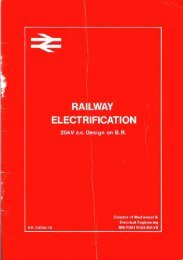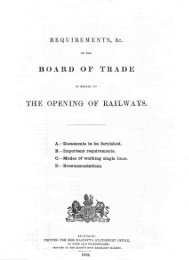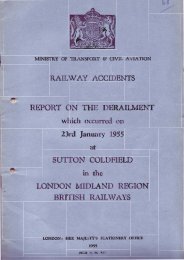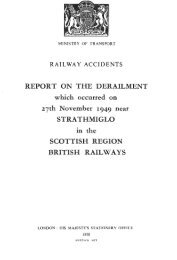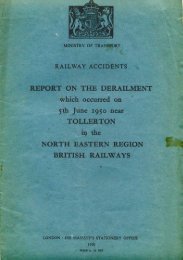R A I LT R AC K - The Railways Archive
R A I LT R AC K - The Railways Archive
R A I LT R AC K - The Railways Archive
You also want an ePaper? Increase the reach of your titles
YUMPU automatically turns print PDFs into web optimized ePapers that Google loves.
sustaining<br />
This year’s Railway<br />
Group Safety Plan<br />
sets a ten-year<br />
objective to further<br />
halve the level of risk<br />
on the rail network<br />
by 2009<br />
42<br />
4.7<br />
4.7 Safety developments<br />
In the past ten years,safety on the GB rail network has<br />
improved significantly under most measures (see charts<br />
opposite).Figures recently published by the European<br />
Transport Safety Council (ETSC) show that, for the EU as a<br />
whole, rail is now 27 times safer than road,and twice as safe<br />
as air per passenger kilometre , and 16 times safer than road<br />
and 18 times safer than air per hour exposed (which ETSC<br />
believes to be the best method for mode-to-mode<br />
comparisons even when many trespasser casualties are<br />
included within the rail figures).<br />
This ye a r ’s Railw ay Group Safety Plan sets a ten-ye a r<br />
o b j e c t i ve to further halve the level of risk on the rail netwo rk<br />
by 2009. I n t e g ral to achievement of the ove rall Plan objective<br />
is a requirement that infra s t ructure renewal and enhancement<br />
is progressed in a way which delive rs the maximum affo r d a bl e<br />
i m p r ovements in safety perfo rm a n c e.This is implicit within all<br />
i nvestment schemes detailed in this NMS.<br />
Technical development of the Train Protection Warning<br />
System (TPWS),which provides a significant improvement in<br />
performance over that available through the Automatic<br />
Warning System (AWS) that is already fitted to most of the<br />
network,continues to plan.<br />
Early in 1998,the functionality of the TPWS was<br />
demonstrated to the Health and Safety Commission;their<br />
Executive has also been party to the field trials of the TPWS<br />
on the Thameslink route which have been successfully<br />
concluded.<strong>The</strong> reliability of both the infrastructure and on-<br />
train elements of the TPWS has been demonstrated. We can<br />
now complete the TPWS installation on the Thameslink<br />
Corridor and the Tonbridge–Hastings route to validate<br />
installation methodology and costs before roll-out across the<br />
network.<br />
In parallel,negotiations are continuing with Her<br />
Majesty’s Railway Inspectorate (HMRI) to finalise agreement<br />
on the fitment criteria and installation programme by which<br />
we will comply with the Railway Safety Regulations 1999,<br />
under which a train protection system is required network-<br />
wide by the beginning of 2004.Definitive agreement with<br />
HMRI must be concluded by mid-1999 to achieve the<br />
already tight implementation deadline without unreasonably<br />
inflating costs.<br />
We have been fully supportive of the Regulations which<br />
mandate adoption of our TPWS as the baseline route to<br />
enhanced train protection.<strong>The</strong> infrastructure fitment costs,<br />
estimated at £140M,are a fraction of what we believe it<br />
would cost to fit the network with ATP which would also<br />
take significantly longer to install,and deliver very limited<br />
further safety benefits.<strong>The</strong> introduction of TPWS is seen<br />
as particular ly important given the levels of growth now<br />
being seen which inevitably lead to trains encountering more<br />
red signals.<br />
Alternative train protection arrangements already in<br />
place will be retained,except where the proportion of<br />
‘captive’train operation is low and dual-fitting with the TPWS<br />
would be required under the Regulations.<br />
Once the TPWS installation is complete, the risk arising<br />
from trains passing red signals will be substantially reduced.<br />
ATP functionality is integral to the design of the TCS<br />
under development for application on the WCML to<br />
increase linespeeds to a maximum of 140mph by 2005.<br />
<strong>The</strong> TCS,for which Alstom has been contracted to<br />
complete development,is more fully described under our<br />
signalling strategy on page 38.<br />
<strong>The</strong> adoption of new TCSs,tilting trains and higher<br />
speeds on the WCML,and potentially on other corridors<br />
requires development of a portfolio of risk-based Railway<br />
Group Standards (RGS).An holistic, system-level approach<br />
has been pursued to the stage that ‘proposals in principle’<br />
were issued for stakeholder review in January 1999.This<br />
process is also taking account of the emerging technical<br />
standards for interoperability which will underpin delivery of<br />
the EU interoperability directive expected to come into<br />
force in spring 1999.<br />
<strong>The</strong> progress made within the SRP to address<br />
defective roofs,platforms and other station facilities will<br />
deliver safety benefits through reducing the numbers of ‘trips,<br />
slips and falls’.<br />
<strong>The</strong> safety of our workforce , and of our contractors’<br />
staff,is of equal importance to that of passengers.After an<br />
18-month period without a fatality, five fatalities in 1998 in<br />
the workforce contracted to Railtrack highlight the<br />
importance of initiatives to reduce the risk to those exposed<br />
to moving trains when maintaining and renewing the<br />
infrastructure. Achievements of particular significance in 1998<br />
were the approvals for deployment of rigid safety barriers<br />
and the first portable automated track safety warning system



